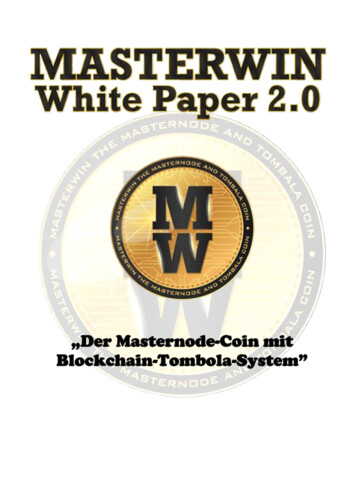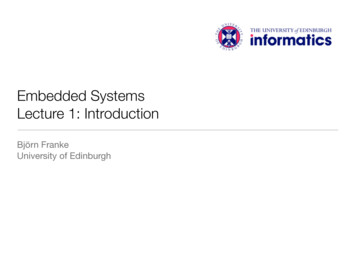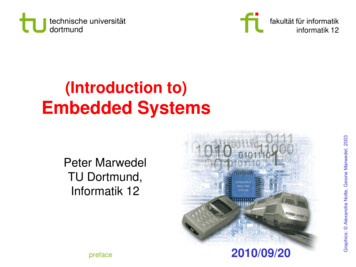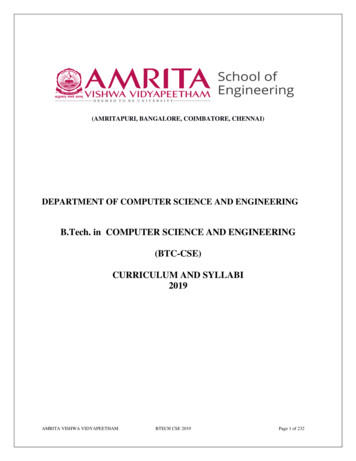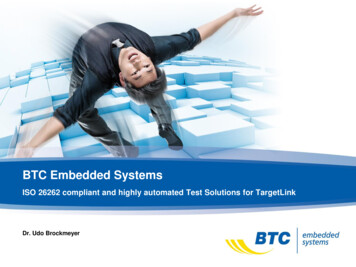
Transcription
BTC Embedded SystemsISO 26262 compliant and highly automated Test Solutions for TargetLinkDr. Udo Brockmeyer
Agenda About BTC Introduction Requirement-based Testing Back-to-back Testing Formal Specification and Formal Verification Conclusion Future Challenges for Automatic Test andVerification Tools
Agenda About BTC Introduction Requirement-based Testing Back-to-back Testing Formal Specification and Formal Verification Conclusion Future Challenges for Automatic Test andVerification Tools
BTC Embedded Systems AG Company established in 1999 BTC-ES Headquarter in Oldenburg (D) Subsidiaries in Munich and Berlin (D) BTC Japan Co., Ltd. Distributors in Sweden, India and South Korea OldenburgBerlin Munich Tokyo Mission Statement:Our mission is to enable customers to increase product quality in a shorteneddesign phase by introducing automatic test and verification technology to the modelbased systems & software development process. Main Customer Domains:Automotive, Aerospace4
BTC Embedded System AG – Market FocusTool Vendor in Embedded Systems Domain:Software Development: Automatic Testing & Formal Verification Domain: 95% Automotive Model Based: MathWorks Simulink & dSPACE TargetLink Strategic Partner: dSPACE BTC Tools: EmbeddedTester, EmbeddedValidator, EmbeddedSpecifier Standards: IEC 61508, ISO 26262System Design: Automatic Testing5 Domain: Aerospace, Defense, Automotive and others Model Based: SysML with IBM Rhapsody Strategic Partner: IBM Rational BTC Tools: TestConductor, ATG IEC 61508, ISO 26262 and mainly DO 178B/C
Strategic Partnership with dSPACE BTC products are highly integrated into Simulink/TargetLink Common Marketing and Development Activities together with dSPACE Common Certified Tool-Chain to support IEC 61508 and ISO 26262 Standards6
BTC Embedded Systems – Partial User List7
Agenda About BTC Introduction Requirement-based Testing Back-to-back Testing Formal Specification and Formal Verification Conclusion
BTC Embedded Systems - Introduction1. Do you want to test your model or your code?2. How much time do you spend with writingand executing test cases?3. What if your PC could understandyour requirements?
ISO 26262 Functional safety standard for automotive Provides an automotive safety lifecycle including software development and testing Explicitely adresses model based design and model based testing
BTC EmbeddedTester – Qualified for ISO 26262BTC EmbeddedTester is certified as „Fit for purpose“ for ISO26262Reference Workflow for TargetLink BTC EmbeddedTester available
Testing and verificationDoes my system behave asexpected?Did I test everything?Requirement-based TestingIs my selected scaling approriate?Is there dead code?Do model and code always deliverthe same results?Back-to-Back TestingAre there test cases that violate arequirement?Can a requirement ever be violated?Formal Verification
Model Based Development – 3 Test MethodsRequirement-based TestingBack-to-Back TestingDevelopmentFormal VerificationVerificationTextual RequirementsCreate manuallyTextual Spec e.g. in DoorsFunctional ModelTest Casese.g. SignalBuilder, Excel, .matSimulationSimulink ModelImplementation ModelTargetLink nSimulationC-CodeANSI C-CodePurpose: Show that model and codecorrectly implement requirements.SIL/PIL
Model Based Development – 3 Test MethodsRequirement-based TestingBack-to-Back TestingDevelopmentFormal VerificationVerificationAutomatically generatedTest CasesGoal: High Structural CoverageFunctional ModelReference SimulationMILSimulink ModelImplementation ModelBack-to-Back TestMILTargetLink ModelReportIncl.CoverageInformationBack-to-Back TestC-CodeANSI C-CodePurpose: Show that model and codeare equivalent (structural testing)SIL/PIL
Model Based Development – 3 Test MethodsRequirement-based TestingBack-to-Back TestingDevelopmentFormal VerificationVerificationformalizeTextual RequirementsFormalized RequirementsTextual Spec e.g. in DoorsSimulation basedFunctional Modelformal verificationSimulink ModelSimulation basedImplementation ModelTargetLink Modelformal verificationSimulation basedC-Codeformal verificationPurpose: Show that requirementsANSI C-Codeare not/cannot be violated.Complete Analysis
Agenda About BTC Introduction Requirement-based Testing Back-to-back Testing Formal Specification and Formal Verification Conclusion Future Challenges for Automatic Test andVerification Tools
Model Based Testing- MotivationInducedRepairCostErrorsToo many defectsbeing introduced !DefectsFoundDevelopmentIntegrationHW/SW integrationDefects beingdetected too late !OperationTestProblem: 80% of development costs are spent identifying and fixing defectsSolution: Systematic and efficient unit test allows to discover errors earlier
Model-based Testing - ChallengesHandling ofTraceability betweenCalibration ParametersTests and RequirementsCode CoverageTest execution on Model andReportingProduction CodeModel CoverageDebugging Problem: A collection of not well integrated tools and scripts Solution: Integrated Test Environment as „one-stop“ solution for model and code20
Embedded Tester – Requirement-based TestingCreate Test CasesExecute Test CasesCalculate Coverage Before creating or importing test cases, requirements can be imported inorder to link and trace test cases to requirements. Direct access to DOORS or PTC Integrity Databases
Embedded Tester – Requirement-based TestingCreate Test CasesExecute Test CasesCalculate CoverageCreate or import/export functional tests
Embedded Tester – Requirement-based TestingCreate Test CasesExecute Test CasesCalculate CoverageModel RefinementModelSimulink-MILModelAutomatic CodeGenerationCompare to referenceTargetLink-MIL C-CodeCompilationSILImport?Obj-CodeTest CasesPIL
Embedded Tester – Integration with TargetLinkCreate Test CasesExecute Test CasesCalculate Coverage1. Strong hierarchical approachTarget-CodeF1 ( ) {Modell Automatic analysis of model hierarchy Easily test and debug sub-functions in modeland code No need to extract system under test manually Automatic detection of interface variables on allhierarchy levels Possibility to treat DISP variables as output Possibility to treat CAL variables as input}F1F2:F4 ( ) { F3F4}Main (){ Automatically Generated}Test Harnesses2. Grey BoxCALInOutDISP
Embedded Tester – Test ExecutionCreate Test CasesExecute Test Cases Test Report Generation (HTML, PDF). Automatic comparison and setting ofPASSED/FAILED Direct link to test management for viewor export for debugging.Calculate Coverage
Embedded Tester - DebuggingCreate Test CasesExecute Test CasesCalculate CoverageDebugging Environment can be created for any hierarchy level!
ISO 26262 - CoverageCreate Test CasesExecute Test CasesCalculate Coverage
Reporting: Requirements Coverage ReportCreate Test CasesExecute Test CasesCalculate CoverageRequirements Bi-directional traceability between requirements and test cases Identify untested requirements Identify violated requirements28ModelCode
Reporting: Model Coverage ReportCreate Test CasesExecute Test CasesCalculate CoverageRequirements Coverage information based on Simulink V&V Toolbox Coverage is cumulated for runs on different model hierarchy levels Intuitive Graphical Colouring of Simulink and Stateflow charts.29ModelCode
Reporting: Code Coverage Analyse ReportCreate Test CasesExecute Test CasesCalculate CoverageRequirementsModelCode Global Code Coverage (Coverage Statistics, Condition, Decision, C/DC,MC/DC, Switch and Function Coverage) Detailed Code Coverage (UID for test properties, links to the code and modelparts) Coloured Code Coverage (Source Code with Coloured Coverage Indication)30
Agenda About BTC Introduction Requirement-based Testing Back-to-back Testing Formal Specification and Formal Verification Conclusion Future Challenges for Automatic Test andVerification Tools
ISO 26262 - Coverage
EmbeddedTester – Back-to-Back TestingStimuli Vector GenerationRecording Reference OutputsModel RefinementModelBack to BackTestingSimulink-MILModelAutomatic CodeGenerationBack-to-Back TestingTargetLink-MIL? automatically 100%CoveragePIL
BTC EmbeddedTester - Test Goals 34Structural Coverage Goals Statement Coverage Condition Coverage Decision Coverage Switch-Case-Coverage Function-Call-Coverage Modified Condition/Decision Coverage Domain CoverageRobustness Analyse Relational Operators Division-by-Zero Down-casting Range Violation UnreachableExample
Embedded Tester – Use cases for Back-to-Back TestingTargetLink Model vs. Code1. Typical use case in order to compare Simulink Model (MIL) to C-Code (SIL/PIL)Simulink Model vs. TargetLink Model2. Useful in case an original Simulink Model (e.g. provided by a customer) is modified to become a TargetLink Model(e.g. because of unsupported blocks or for optimization reasons)Current Model Version vs. Previous Model Version3. 4.Automatic regression test between model versionsCurrent Matlab/TargetLink Version vs. Previous Version The EmbeddedTester Migration Suite allows to verify automatically, that the migration to a new Matlab and/orTargetLink version does not change the behavior of models and production code.35
Embedded Tester – Test AutomationConfiguration36Report
Agenda About BTC Introduction Requirement-based Testing Back-to-back Testing Formal Specification and Formal Verification Conclusion Future Challenges for Automatic Test andVerification Tools
ISO 26262 Quality Aspects A Hierarchy of Notation Methods is defined The more safety critical a function is, the more formal the notation andverification is recommended38
Formal verification vs. TestingTestingFormal verification using Model checking Problem: A testcase only represents one possible path through the system It is impossible to cover all paths with test cases Solution: Model checking analyses all possible paths and guarantees a bug-free system39
Challenges when specifying requirements in a formal way Problem1: Some languages that mightbe used to express requirements are notformalSimulink/Stateflow Problem2: Formal methods are oftenPython.m scriptsExample of a formal specification in LTLconsidered to be too mathematical andtoo difficult to learn Solution: A tool that allows engineers to take their textual requirements and intuitivelyderive semi-formal and formal notations40
Formal Specification with PatternsFormal Specification41Formal Verification Intuitive formalization process thanks to Pattern library in EmbeddedSpecifier Non-ambiguous representation helps to improve the quality of requirements Formalized requirements are later used in Formal Verification process “Proven in use” in Automotive and Avionics Industry
Simulation-based Formal VerificationFormal SpecificationFormal VerificationSimulation-basedSolution 1: Co-SimulationComplete AnalysisSolution 2: Offline-VerificationTest EnvironmentBTC EmbeddedSpecifierFormal SpecificationExportTest EnvironmentBTC EmbeddedValidator BASEImportTest CasesRequirementObserverTest DataObserveFormal SpecificationSystem Under TestPROOFRequirement StatusFullfilled / Violated42Test case XYviolatedRequirement 5Requirementfullfilled
EmbeddedValidator - MethodFormal SpecificationFormal VerificationSimulation-baseddSPACE TargetLinkSafetyRequirementsComplete AnalysisBTC EmbeddedSpecifierBTC EmbeddedValidatorFormal RequirementTargetLink Code Code does not fulfillthe requirement43Counter ExampleCode fulfillsrequirement
Agenda About BTC Introduction Requirement-based Testing Structural Testing (Back-to-back Testing) Formal Specification and Formal Conclusion VerificationFuture Challenges for AutomaticTest and Verification Tools
Conclusion – 3 Test Methods45 Requirements-based testing usuallyfinds about 20-40% of the problems. additional 30-40% of the softwareproblems can be directly found by usingstructural testing and back-to-backcomparison (Small effort due to automatictest case generation and test execution) Formal verification is especially relevantfor testing of safety-critical ack-to-BackTestRequirementbased TestEffortIssuesfound* Metrics Source: GermanAutomotive OEM – ModelBased Project. Combination of test methods is recommended to achieve high quality ISO 26262 provided guidelines on the test methods to be used for each ASILBTC Embedded Systems AG proprietary · all rights reserved45
BTC Embedded Systems - ToolchainRequirement-based Testing Create and manage functionaltest casesBack-to-Back Testing Automatic test casegeneration for full structuralcoverage on production code Import requirements (e.g.DOORS) and link test casesto requirements Execution of Back-to-BackTest Automatic MIL/SIL/PIL testexecution on any hierarchylevel User-defined structural testgoals (Equivalence Class,Boundary, etc.) Automatic test evaluation Includes all Features fromBTC EmbeddedTester BASE Coverage Reports forRequirements, Model andCodeFormal Verification Formal Specification based on pattern library Import of informal requirements from DOORS, PTC Integrity,Excel, etc. Intuitive creation of semi-formal and formal requirements Full traceability of requirementsBTC EmbeddedSpecifier Simulation-based FormalVerification Formal Verificationusing ModelCheckingTechnology Generation of a debugenvironment in Simulink orMSVCBTC EmbeddedTester BASEBTC EmbeddedTesterBTC Embedded Systems AG proprietary · all rights reserved46BTC EmbeddedValidatorBASEBTCEmbeddedValidator
ConclusionBTC EmbeddedTesterBASEBTC EmbeddedSpecifierBTC EmbeddedValidatorCOMPLETE Requirement-Based-Testing for Simulink/TargetLink-Models and C-Code Highly integrated with dSPACE TargetLink Connection to Requirements-Management Tools like DOORS Automatic test execution (MIL/SIL/PIL) on any hierarchy level Automatic generation of debugging environments Integrated coverage measurement (requirements coverage, model coverage, code coverage)47
ConclusionBTC EmbeddedTesterBASEBTC EmbeddedSpecifierBTC EmbeddedValidatorCOMPLETEEfficiency ImprovementsCustomer experiences show a decreasing overall test effort by 50 to 70% Test case generation effort for maximal structural coverage could be minimized by 90%! Effort savings of up to 70% during test execution and test evaluation phases Half of the debugging effort could be saved by using interactive and automatic debugging tool supportQuality ImprovementsImproved „Maturity Gates“ In average the MC/DC Coverage rates are 30% higher in contrast to manual test approachesProcess ImprovementISO26262 Certified Tool-Chain with BTC EmbeddedTester supports Standard conform developmentand test process48
Success Story: BTC EmbeddedTester BTC EmbeddedTesterBTC EmbeddedSpecifierBTC EmbeddedValidator"MAN Nutzfahrzeuge AG successfully uses EmbeddedTester as a standardAutomatic Test Environment for the leading AutoCode Generator TargetLinkin the Model Driven Development of series-production Power Trainapplications.The automatic test generation, execution, analysis and debug capabilities ofEmbeddedTester is one important key to fulfill the high efficiency and qualitylevels of MAN Nutzfahrzeuge AG, under the permanent time-to-marketpressure.”Stefan Teuchert,Head of the Department Software-Development and Base Technologies, MAN Nutzfahrzeuge AG(Munich)49
ConclusionBTC EmbeddedTesterBTC EmbeddedSpecifierBTC EmbeddedValidator Can be intuitively used by requirements engineers or function developers to create semi-formaland formal requirements (Semi-)Formal and unambiguous representation helps to improve requirements quality Import from (and traceability to) RM-tools like DOORS and PTC Integrity Automatic translation into machine readable specification in order to use requirements in theverification process Directly supports safety standards like IEC 61508 & ISO 26262 Highly recommended for Safety Critical Applications50
ConclusionBTC EmbeddedTesterBTC EmbeddedSpecifierBTC EmbeddedValidatorBASECOMPLETE Simulation Based Formal Verification allow crosschecking of all test cases against allrequirements Integrated reporting with full traceability to original requirements Flexible concept for supporting different test environments: Support for Simulink models and TargetLink models available Support for dSPACE VEOS and dSPACE HIL-Systems planned for 2014 Other test architectures can be easily integrated51
ConclusionBTC EmbeddedTesterBTC EmbeddedSpecifierBTC EmbeddedValidatorBASECOMPLETE Mathematical proof that Code can never violate a requirement Check requirements on any hierarchy level of a model For requirements that can be violated, a counter example and a debugging model is generatedautomatically52
Agenda About BTC Introduction Requirement-based Testing Structural Testing (Back-to-back Testing) Formal Specification and Formal Conclusion Future Challenges for Automatic Test andVerification Tools
Future Challenges for Automatic Test and Verification Tools541.Optimized “off-the-shelf” integration into customerprocesses and tool chains3.Solution: Open interfaces to connect existing customer databackbone of MBD ProcessProviding a framework for a complete toolchain qualification for safety-criticalapplicationsSolution: any V&V activity in the MBD Process is related toexisting data-backbones providing full traceability2.Dedicated customer workflow support and improvedusabilitySolution: Generalized test artifact management via V&VToolsFocused use case perspectives incl. wizardfunctionalityUnified graphical user interface for all use V&Vcases4.One general validation suite andqualification approachDealing with different complexitiesSolution: Improved test and verification engines runtime and coverage Sohisticated analysis technologies Floating-Point Applications Extended REQ Specification Method –Usability & ExpressivenessOne common technology platform is necessary to provide anefficient & effective customer solutionBTC EmbeddedPlatform54
BTC EmbeddedPlatform Overview55RequirementModelProduction CodeImplementation SYNECTBTC EmbeddedPlatformCommon Architecture/Interface Data-base and BTC-Core FunctionalityBTC EmbeddedTester55BTC EmbeddedSpecifierBTC EmbeddedValidator
„Engines“ available in the BTC EmbeddedPlatform56Engines VIS (Colorado; BDDs) MiniSat (open source, SAT) cbmc (Oxford Uni and Carnegie Mellon; SAT) “BTC-engine” (Oldenburg; several heuristics)Open Challenges Ability to cope with control models and control programs containing non-linear equations with growing demands regarding floating point precion Continuous growth of model and program complexity56
Thank you.
BTC Embedded System AG - Market Focus Tool Vendor in Embedded Systems Domain: Software Development: Automatic Testing & Formal Verification Domain: 95% Automotive Model Based: MathWorks Simulink & dSPACE TargetLink Strategic Partner: dSPACE BTC Tools: EmbeddedTester, EmbeddedValidator, EmbeddedSpecifier

